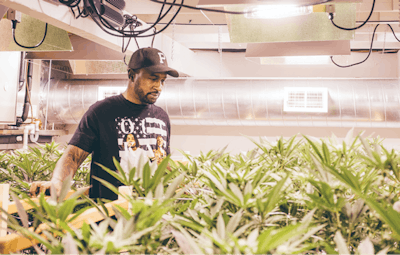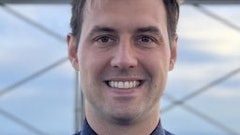Photos by Jake Gravbrot

Jesce Horton is a new breed of cultivator. Not a grower steeped for years in the underground cannabis world or a suit-and-tie convert from the corporate world, Horton is part of a new generation of young professionals bringing specialized skills into the cannabis industry.
Prior to becoming a professional cannabis cultivator, Horton worked in a variety of positions for manufacturing and electronics conglomerate Siemens. One of those positions was Certified Energy Manager, in which he worked with major American manufacturers, including Chrysler, on reducing their energy usage and environmental footprint. Horton and his team earned awards for their work, and those experiences have shaped his cultivation practices.
“I really got that view of the importance of, first, energy-efficiency, and understanding that that's important from a production standpoint, lowering your cost,” Horton says. “But also, I got the real view from the marketing standpoint, and that people care about it, and customers care about it.”
Horton is the first to admit that, as an engineering student at Florida State University, he never thought he would be making a living from cannabis. (“We didn’t really understand what was happening on the West Coast [back then],” he says.)
Today, Horton is the owner of Panacea Valley Gardens, a medical cannabis cultivation business in the Columbia River gorge near Portland, Ore., and of Panacea, a separate, adult-use dispensary. He also is the founder and president of the Minority Cannabis Business Association (MCBA), the first nonprofit to focus on increasing diversity in the cannabis industry, and is developing the Saints Cannabis project, what he hopes will become a Portland cannabis culture hub. And he’s doing it his own way.

Finding Panacea
Horton had some experience growing cannabis prior to opening Panacea Valley Gardens: When he first got to Portland, he grew medical marijuana for two elderly patients who suffered from cancer. He credits his first cultivar, Black Cherry Cheesecake, as one of the main reasons he went into the cannabis cultivation business.
“I got my confidence thinking that it was because I was a great grower, when it was really just really, really great genetics that I had,” he says. “I still have that one strain that I started off with. Not because it has sentimental value, but because it was just an amazing genetic, and I was lucky enough to find it.”
With that confidence, Horton launched Panacea Valley Gardens Jan. 15, 2015. Since then, he and his team have been cultivating medical marijuana in 4,000 square feet of indoor space, including a retrofitted horse barn, and 8,000 square feet of hoop houses.
Access-card-controlled gates surround the grow site, which Horton shares with another cultivator. Panacea Valley occupies two of the four bloom rooms in the retrofitted building, and has another room in another detached space. Horton says he’s been experimenting with different growing mediums, but most of what goes to patients is grown using coco coir.
“The ability to grow at a larger scale was why we chose coco over soil,” he explains, adding that coco coir lets him worry less about inconsistencies.
The indoor facilities are fitted with air filtration systems that use UV lighting to kill any spores or impurities that might come through the ventilation systems. Positive pressure inside the grow rooms also helps keep any contaminants from entering when someone opens the door.
As interesting as his setup might sound (not many horse barns are retrofitted to become medical cannabis facilities), it does come with its fair share of problems. The hoop houses, especially, have taught Horton a lot about the challenges with that type of greenhouse growing.
“What I really learned is, when you're in those types of greenhouses, how susceptible you are, how at-risk you are to the climate, to the environment,” he says. This past summer, Panacea Valley Gardens was hit by the remnants of Typhoon Songda. The storm destroyed most of the greenhouse crops. “There's only so much you can do to mitigate that.”
Despite the struggles, Horton and his team have been making the most out of it – in its first five months of operation, Panacea Valley won a Dope Cup for Best Savory Edible. And although it doesn’t make edibles anymore after his chef left the group, the company is still devoted to making craft-quality cannabis.
According to Horton, craft-quality cannabis starts with the right strain selection, which is why he and his partner have searched through over 200 strains for the strongest genetics.
“In going through 200 strains or so, and visiting Cannabis Cups, and picking up what we thought was the best genetics, we're only growing six different strains,” he says, adding that this attention to strain identification and plant health is what allows him to stand out in a crowded Oregon market, especially with “not having a strong cultivation reputation in Oregon, like a lot of the people do who have been here for years and years.”
Horton also has been incorporating some of his engineering knowledge and past experiences into his indoor facility. He custom-built his automation control using a leftover Siemens programmable logic controller, or PLC, that he had in his briefcase. He’s been using that automation system to help reduce his facilities’ energy use by limiting when and how equipment is activated.
“What we were able to do is put in protocol that said, ‘If this part of the room is experiencing high humidity, instead of bringing on the dehumidifier first – which is a significant energy user – let's do more fans in that area.’ So, it'll bring the fans online, before it brings on that dehumidifier,” he explains.
Horton even goes so far as measuring the amount of nutrients left in the water runoff when he feeds his plants. Individually. He does this to understand the differences between every individual plant, adjusts his watering and feedings accordingly, and says that optimizing even those basic aspects of cultivation is “one of the best ways of really having the best resource efficiency.”

Building a Dream
But where Horton really wants to put his skills on display is in his next big project: Saints Cannabis.
“Saints Cannabis is my dream coming true,” Horton says.
Currently, Saints Cannabis is an empty, three-acre lot with a 25,000-square-foot warehouse between Portland’s downtown and its airport. But where some see an empty lot, Horton sees an opportunity to build a brand.
“What we're building with this facility, is a hybrid of that craft brew industrial space, and the winery space, right here in a very convenient location,” he says.
Horton is hedging that the cannabis market is not going to just resemble the winery model or the craft brew model, but rather is going to combine aspects of both. He expects cannabis tourism will attract people who “want to see the cultivation, they want to see it grow, they want the atmosphere of nature. But they also want that close proximity of the city, and being able to do things like go to a Blazers game, or things like that.”
Saints Cannabis will have an adult-use growing operation, a dispensary, a research and development lab, an extraction lab, an edibles kitchen, a boutique hotel – only eight or so rooms, Horton estimates – an event space, and an area where customers may consume their cannabis on site.
Horton also wants to build on both his experiences at Siemens and GE, as well as what he’s learned at Panacea Valley Gardens, when it comes to energy efficiency. One of the upgrades he would like to make is to his automation system — to have one that is more compatible with the processes of a cannabis cultivation business and that would be able to track more variables. Just the latter, he says, is enough to help cultivators cut their energy use in half.
“The Department of Energy did a study that said [for] industrial facilities, of all of the energy-saving projects … of all the stuff you could possibly do, 40 to 50 percent of all of your energy-saving potential is going to come from information: tracking, monitoring and communication.”
Saints Cannabis is still very much a work in progress. According to Horton, the project is six to 12 months away from being licensed, and another 12 to 24 months away from being fully operational.
Conflicts and Cannabis
Before Panacea Valley Gardens, Horton’s first real experience with the plant came from the criminal justice system: His father was sent to jail over a cannabis-related offense when Horton was just a boy. As a result, his parents were very strict when it came to their youngest son and cannabis.
“I would come home, and my mom would be looking in my eyes, trying to see how red they were. … Or my dad would come and give me surprise drug tests whenever I got home from school,” Horton remembers.
Despite his parents’ best efforts, Horton was more attracted to following his older brother and cousin, both of whom are now working with him at Panacea Valley Gardens.
“They were always the ones going off and sneaking and smoking cannabis together, while I'm the little young kid who can't tag along,” Horton says with a chuckle.
When he started consuming cannabis, he noticed it actually helped him, especially when it came to studying, he says. He even credits cannabis with turning his math grades from Cs to As. “When I started smoking, I was able to really zero in on those math problems, or just kind of stay still for long enough to understand them,” he says.
Despite a few run-ins with law enforcement over cannabis (he was arrested on three occasions on cannabis charges), those better grades gave Horton the opportunity to study industrial engineering at Florida State University, where he graduated with honors. After an internship at GE, Horton began his seven-year career at GE’s rival, Siemens.
Horton realizes how lucky he was to not get caught up in the criminal justice system like his father, or that his arrest record did not keep him from getting a job. (“Siemens actually overlooked it whenever they found it, because I had such a great background with General Electric,” Horton says.)
“The only problem that I had with cannabis seemed to be the social justice and the perception of [it],” Horton says. But, he adds, “That also fueled me, I think, to have more of a passion and purpose behind the industry, once I was able to join from a more professional standpoint.”
Minorities in the Cannabis Industry
When Horton is not tending his crops at Panacea Valley or working with his partner on his plans for Saints Cannabis, Horton spends time on one of his other projects: the Minority Cannabis Business Association (MCBA).
Horton’s experiences with cannabis, both positive and negative, have shaped the work he does with the organization he founded in April 2016 after speaking with different industry members over the course of more than six months. He describes the group’s mission as creating “equal access and economic empowerment for cannabis businesses, their patients and the communities most affected by the War on Drugs.”
According to Horton and the MCBA, minorities face three main issues when it comes to the cannabis industry: economic barriers, the negative perception of the industry due to the War on Drugs, and a lack of cannabis education.
“When you have fees that are hundreds of thousands of dollars, and millions of dollars that you have to have in the bank [per state requirement], the amount of people of color that have access or have networks that can come up with that kind of money is pretty much slim to none,” Horton says.
To help address the economic hurdles often faced by minorities looking to join the cannabis industry or otherwise, Horton and the MCBA worked with the city of Portland to incorporate tax appropriations that directly benefit minority communities. According to him, tax appropriations allow entire communities to enjoy proceeds, not just cannabis-business owners.
“Some people who have been disadvantaged don't want to own a business, they don't want to work [in the] cannabis industry, but they're still in a negative position, and their communities are worse off because of the damage done by the war on drugs,” he explains. Those tax dollars will go to community assistance, job assistance and incubator programs, as well as to women- and minority-owned business owners.

“The ability to open up these tax dollars for these things are one of the best things that can help communities, and something that we want to push across the nation. We think that if each municipality, each city can do something like this, just imagine the ability to really focus on those issues and those communities.”
Lowering application fees and asset requirements are other solutions the MCBA proposes to address the diversity issue in cannabis.
As for industry education and perception, Horton suggests a more boots-on-the-ground approach.
Going out into the community and sponsoring community programs, teaching people about cannabis and its cultivation are all ways cultivators can increase diversity in the cannabis industry, Horton says.
“My parents, they didn't want me to have anything to do with ‘weed’ ... because what they knew, their reality with cannabis was bad. People get taken to jail, it hurts us – all these different types of things that they feel, and that's what's happening in our communities.”
The MCBA has been leading the charge when it comes to community involvement as well, partnering with Marley Natural (the official cannabis brand for the late musician Bob Marley) for the Rise Up Expungement program.
The program takes former felons convicted of cannabis-related crimes, most of whom are minorities, and, as Horton explains, “we bring in the attorneys, we bring in the fingerprint reps, we bring in everyone that is needed in order to get all that expungement paperwork done, and shipped off, and paid for by Marley Natural, to get their record expunged."
While he doesn’t expect everyone to go to the same lengths as he has gone, both in his social-justice involvement and energy-efficiency initiatives, Horton urges cannabis business owners to see the value in being more inclusive and diverse.
“It's a two-sided thing: The social good, the moral argument, is directly connected to the economic potential of our industry,” Horton says. “If we look at that and make that a core principal of our industry, I think that ... we'll be able to not just have another industry, but have a better industry.”
















